2007 ISUZU KB P190 fuel filter
[x] Cancel search: fuel filterPage 1709 of 6020
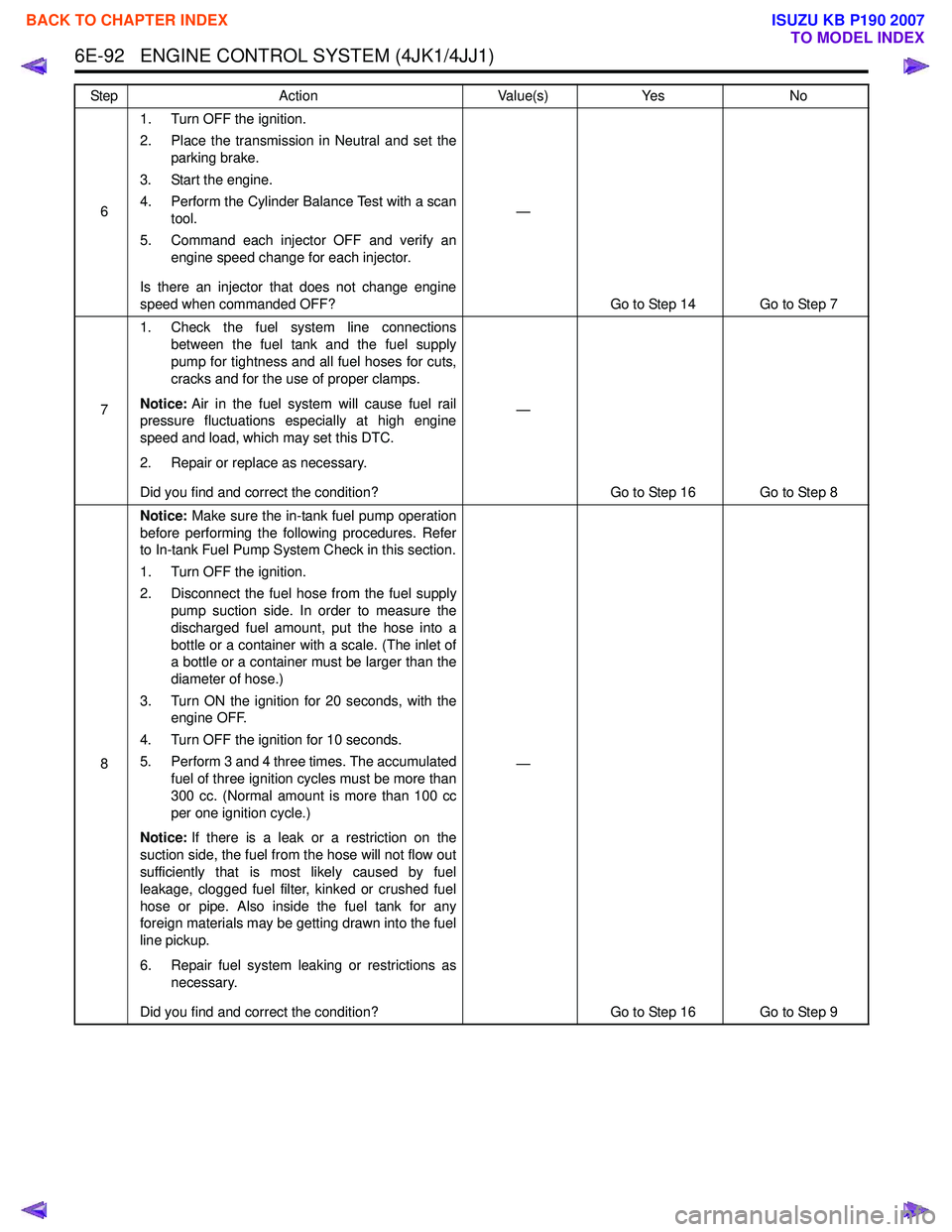
6E-92 ENGINE CONTROL SYSTEM (4JK1/4JJ1)
61. Turn OFF the ignition.
2. Place the transmission in Neutral and set the parking brake.
3. Start the engine.
4. Perform the Cylinder Balance Test with a scan tool.
5. Command each injector OFF and verify an engine speed change for each injector.
Is there an injector that does not change engine
speed when commanded OFF? —
Go to Step 14 Go to Step 7
7 1. Check the fuel system line connections
between the fuel tank and the fuel supply
pump for tightness and all fuel hoses for cuts,
cracks and for the use of proper clamps.
Notice: Air in the fuel system will cause fuel rail
pressure fluctuations especially at high engine
speed and load, which may set this DTC.
2. Repair or replace as necessary.
Did you find and correct the condition? —
Go to Step 16 Go to Step 8
8 Notice:
Make sure the in-tank fuel pump operation
before performing the following procedures. Refer
to In-tank Fuel Pump System Check in this section.
1. Turn OFF the ignition.
2. Disconnect the fuel hose from the fuel supply pump suction side. In order to measure the
discharged fuel amount, put the hose into a
bottle or a container with a scale. (The inlet of
a bottle or a container must be larger than the
diameter of hose.)
3. Turn ON the ignition for 20 seconds, with the engine OFF.
4. Turn OFF the ignition for 10 seconds.
5. Perform 3 and 4 three times. The accumulated fuel of three ignition cycles must be more than
300 cc. (Normal amount is more than 100 cc
per one ignition cycle.)
Notice: If there is a leak or a restriction on the
suction side, the fuel from the hose will not flow out
sufficiently that is most likely caused by fuel
leakage, clogged fuel filter, kinked or crushed fuel
hose or pipe. Also inside the fuel tank for any
foreign materials may be getting drawn into the fuel
line pickup.
6. Repair fuel system leaking or restrictions as necessary.
Did you find and correct the condition? —
Go to Step 16 Go to Step 9
Step
Action Value(s)Yes No
BACK TO CHAPTER INDEX
TO MODEL INDEX
ISUZU KB P190 2007
Page 1711 of 6020
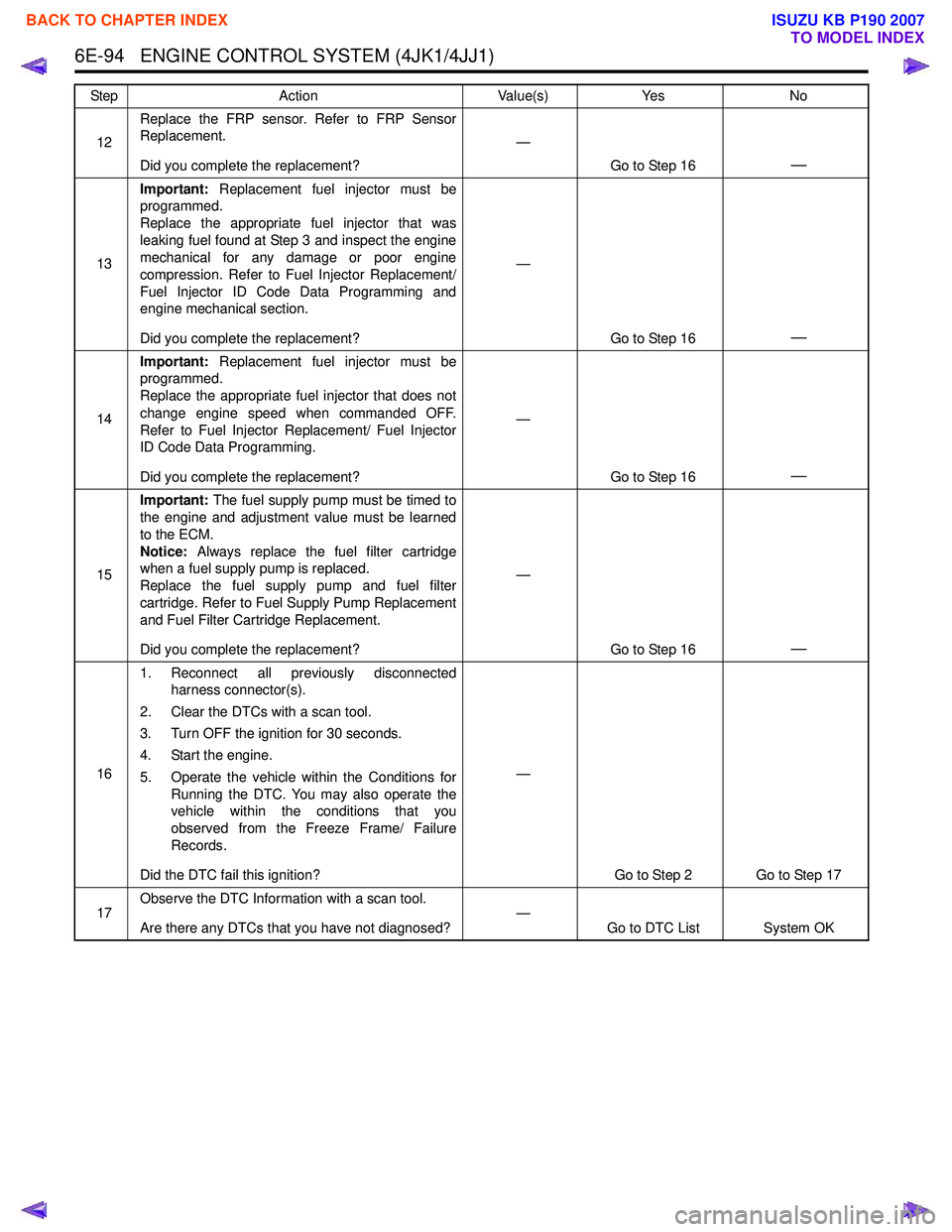
6E-94 ENGINE CONTROL SYSTEM (4JK1/4JJ1)
12Replace the FRP sensor. Refer to FRP Sensor
Replacement.
Did you complete the replacement? —
Go to Step 16
—
13Important:
Replacement fuel injector must be
programmed.
Replace the appropriate fuel injector that was
leaking fuel found at Step 3 and inspect the engine
mechanical for any damage or poor engine
compression. Refer to Fuel Injector Replacement/
Fuel Injector ID Code Data Programming and
engine mechanical section.
Did you complete the replacement? —
Go to Step 16
—
14Important:
Replacement fuel injector must be
programmed.
Replace the appropriate fuel injector that does not
change engine speed when commanded OFF.
Refer to Fuel Injector Replacement/ Fuel Injector
ID Code Data Programming.
Did you complete the replacement? —
Go to Step 16
—
15Important:
The fuel supply pump must be timed to
the engine and adjustment value must be learned
to the ECM.
Notice: Always replace the fuel filter cartridge
when a fuel supply pump is replaced.
Replace the fuel supply pump and fuel filter
cartridge. Refer to Fuel Supply Pump Replacement
and Fuel Filter Cartridge Replacement.
Did you complete the replacement? —
Go to Step 16
—
161. Reconnect all previously disconnected
harness connector(s).
2. Clear the DTCs with a scan tool.
3. Turn OFF the ignition for 30 seconds.
4. Start the engine.
5. Operate the vehicle within the Conditions for Running the DTC. You may also operate the
vehicle within the conditions that you
observed from the Freeze Frame/ Failure
Records.
Did the DTC fail this ignition? —
Go to Step 2 Go to Step 17
17 Observe the DTC Information with a scan tool.
Are there any DTCs that you have not diagnosed? —
Go to DTC List System OK
Step
Action Value(s)Yes No
BACK TO CHAPTER INDEX
TO MODEL INDEX
ISUZU KB P190 2007
Page 1845 of 6020
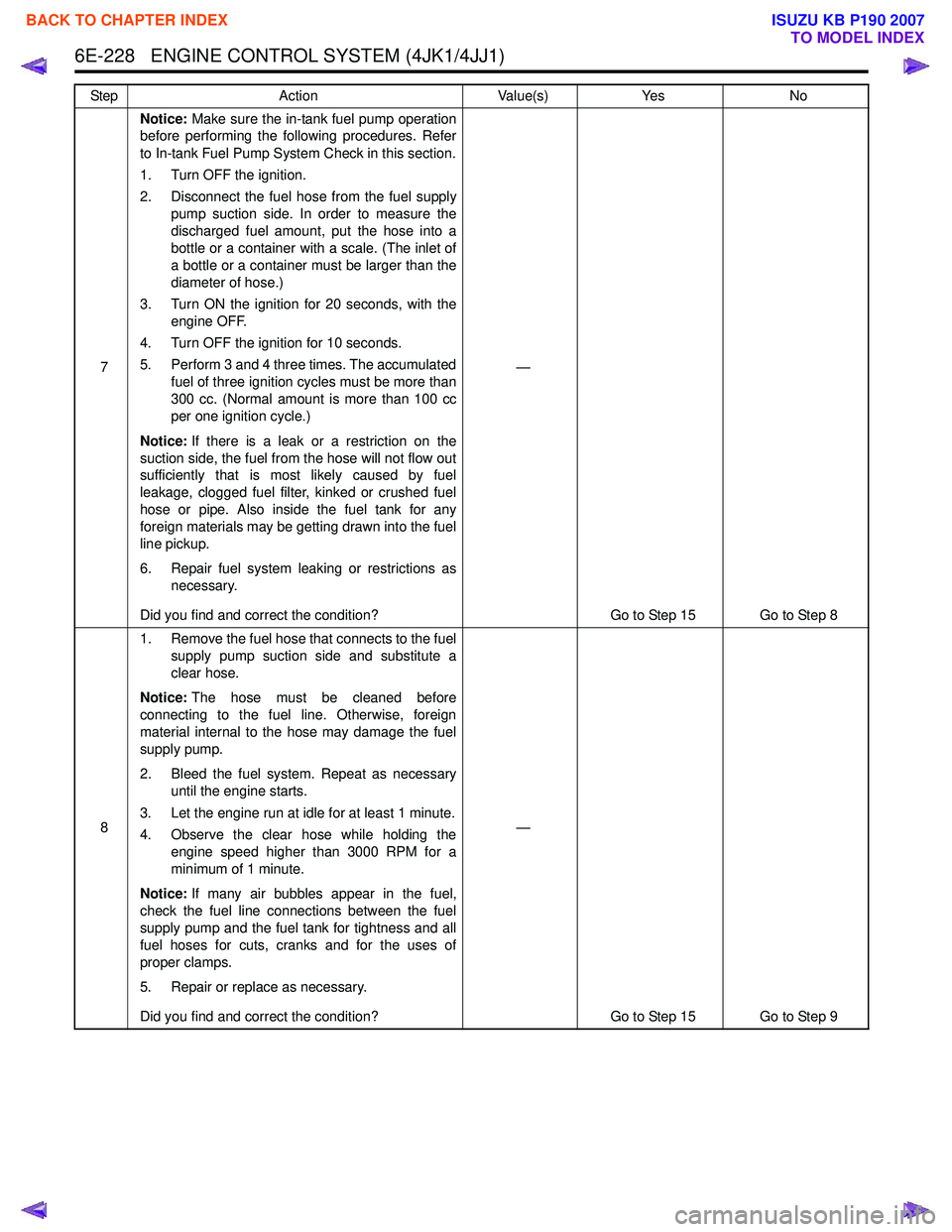
6E-228 ENGINE CONTROL SYSTEM (4JK1/4JJ1)
7Notice:
Make sure the in-tank fuel pump operation
before performing the following procedures. Refer
to In-tank Fuel Pump System Check in this section.
1. Turn OFF the ignition.
2. Disconnect the fuel hose from the fuel supply pump suction side. In order to measure the
discharged fuel amount, put the hose into a
bottle or a container with a scale. (The inlet of
a bottle or a container must be larger than the
diameter of hose.)
3. Turn ON the ignition for 20 seconds, with the engine OFF.
4. Turn OFF the ignition for 10 seconds.
5. Perform 3 and 4 three times. The accumulated fuel of three ignition cycles must be more than
300 cc. (Normal amount is more than 100 cc
per one ignition cycle.)
Notice: If there is a leak or a restriction on the
suction side, the fuel from the hose will not flow out
sufficiently that is most likely caused by fuel
leakage, clogged fuel filter, kinked or crushed fuel
hose or pipe. Also inside the fuel tank for any
foreign materials may be getting drawn into the fuel
line pickup.
6. Repair fuel system leaking or restrictions as necessary.
Did you find and correct the condition? —
Go to Step 15 Go to Step 8
8 1. Remove the fuel hose that connects to the fuel
supply pump suction side and substitute a
clear hose.
Notice: The hose must be cleaned before
connecting to the fuel line. Otherwise, foreign
material internal to the hose may damage the fuel
supply pump.
2. Bleed the fuel system. Repeat as necessary until the engine starts.
3. Let the engine run at idle for at least 1 minute.
4. Observe the clear hose while holding the engine speed higher than 3000 RPM for a
minimum of 1 minute.
Notice: If many air bubbles appear in the fuel,
check the fuel line connections between the fuel
supply pump and the fuel tank for tightness and all
fuel hoses for cuts, cranks and for the uses of
proper clamps.
5. Repair or replace as necessary.
Did you find and correct the condition? —
Go to Step 15 Go to Step 9
Step
Action Value(s)Yes No
BACK TO CHAPTER INDEX
TO MODEL INDEX
ISUZU KB P190 2007
Page 1846 of 6020
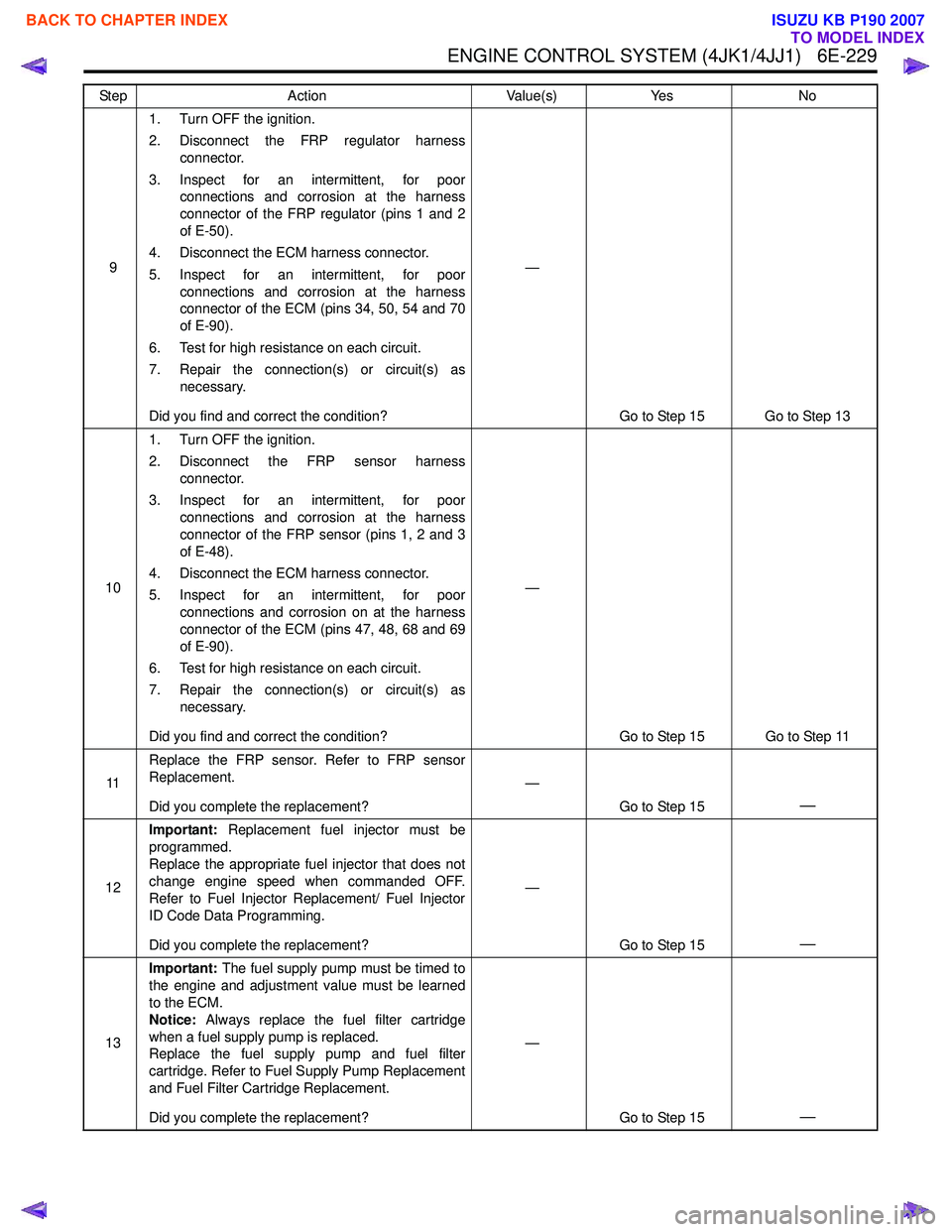
ENGINE CONTROL SYSTEM (4JK1/4JJ1) 6E-229
91. Turn OFF the ignition.
2. Disconnect the FRP regulator harness connector.
3. Inspect for an intermittent, for poor connections and corrosion at the harness
connector of the FRP regulator (pins 1 and 2
of E-50).
4. Disconnect the ECM harness connector.
5. Inspect for an intermittent, for poor connections and corrosion at the harness
connector of the ECM (pins 34, 50, 54 and 70
of E-90).
6. Test for high resistance on each circuit.
7. Repair the connection(s) or circuit(s) as necessary.
Did you find and correct the condition? —
Go to Step 15 Go to Step 13
10 1. Turn OFF the ignition.
2. Disconnect the FRP sensor harness connector.
3. Inspect for an intermittent, for poor connections and corrosion at the harness
connector of the FRP sensor (pins 1, 2 and 3
of E-48).
4. Disconnect the ECM harness connector.
5. Inspect for an intermittent, for poor connections and corrosion on at the harness
connector of the ECM (pins 47, 48, 68 and 69
of E-90).
6. Test for high resistance on each circuit.
7. Repair the connection(s) or circuit(s) as necessary.
Did you find and correct the condition? —
Go to Step 15 Go to Step 11
11 Replace the FRP sensor. Refer to FRP sensor
Replacement.
Did you complete the replacement? —
Go to Step 15
—
12Important:
Replacement fuel injector must be
programmed.
Replace the appropriate fuel injector that does not
change engine speed when commanded OFF.
Refer to Fuel Injector Replacement/ Fuel Injector
ID Code Data Programming.
Did you complete the replacement? —
Go to Step 15
—
13Important:
The fuel supply pump must be timed to
the engine and adjustment value must be learned
to the ECM.
Notice: Always replace the fuel filter cartridge
when a fuel supply pump is replaced.
Replace the fuel supply pump and fuel filter
cartridge. Refer to Fuel Supply Pump Replacement
and Fuel Filter Cartridge Replacement.
Did you complete the replacement? —
Go to Step 15
—
Step Action Value(s)Yes No
BACK TO CHAPTER INDEX
TO MODEL INDEX
ISUZU KB P190 2007
Page 1851 of 6020
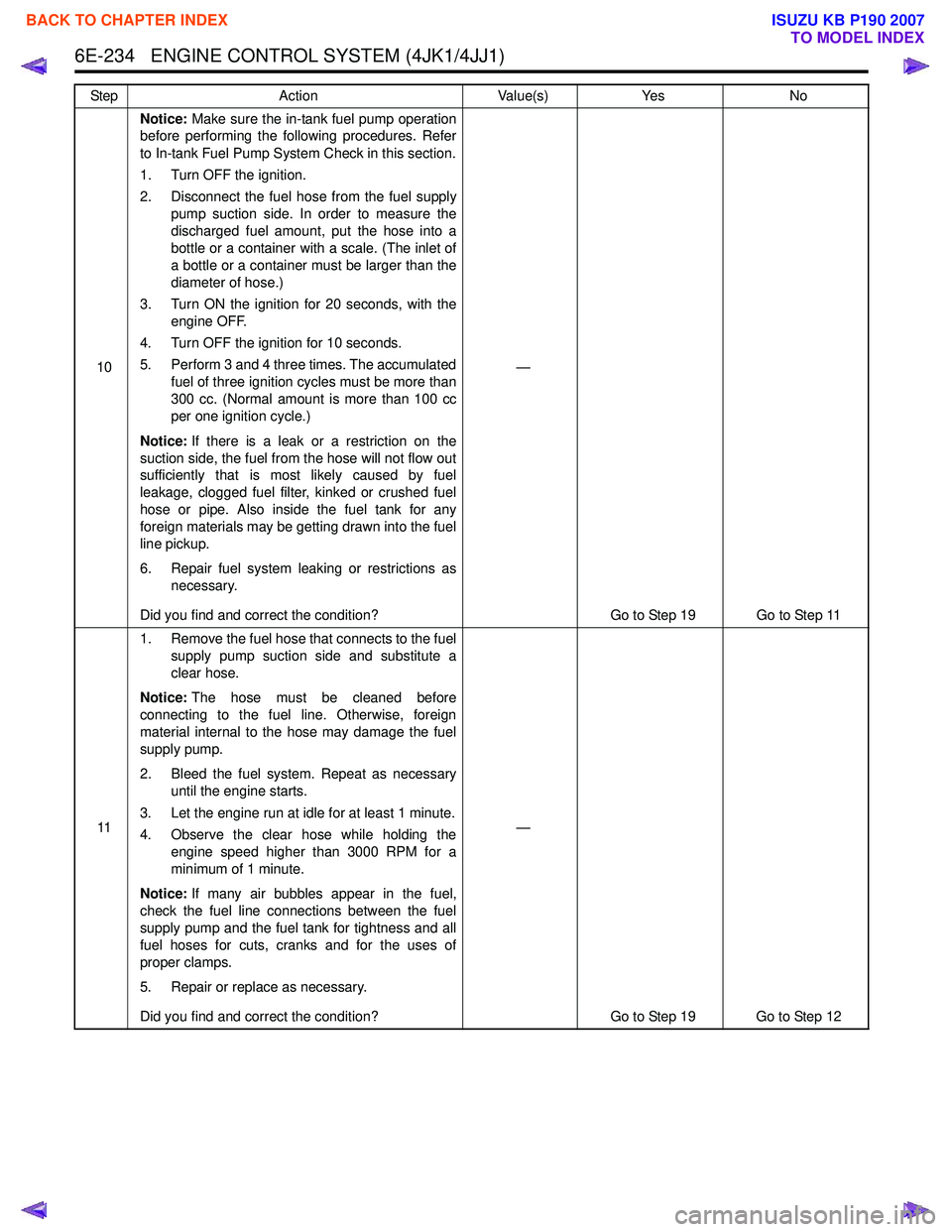
6E-234 ENGINE CONTROL SYSTEM (4JK1/4JJ1)
10Notice:
Make sure the in-tank fuel pump operation
before performing the following procedures. Refer
to In-tank Fuel Pump System Check in this section.
1. Turn OFF the ignition.
2. Disconnect the fuel hose from the fuel supply pump suction side. In order to measure the
discharged fuel amount, put the hose into a
bottle or a container with a scale. (The inlet of
a bottle or a container must be larger than the
diameter of hose.)
3. Turn ON the ignition for 20 seconds, with the engine OFF.
4. Turn OFF the ignition for 10 seconds.
5. Perform 3 and 4 three times. The accumulated fuel of three ignition cycles must be more than
300 cc. (Normal amount is more than 100 cc
per one ignition cycle.)
Notice: If there is a leak or a restriction on the
suction side, the fuel from the hose will not flow out
sufficiently that is most likely caused by fuel
leakage, clogged fuel filter, kinked or crushed fuel
hose or pipe. Also inside the fuel tank for any
foreign materials may be getting drawn into the fuel
line pickup.
6. Repair fuel system leaking or restrictions as necessary.
Did you find and correct the condition? —
Go to Step 19 Go to Step 11
11 1. Remove the fuel hose that connects to the fuel
supply pump suction side and substitute a
clear hose.
Notice: The hose must be cleaned before
connecting to the fuel line. Otherwise, foreign
material internal to the hose may damage the fuel
supply pump.
2. Bleed the fuel system. Repeat as necessary until the engine starts.
3. Let the engine run at idle for at least 1 minute.
4. Observe the clear hose while holding the engine speed higher than 3000 RPM for a
minimum of 1 minute.
Notice: If many air bubbles appear in the fuel,
check the fuel line connections between the fuel
supply pump and the fuel tank for tightness and all
fuel hoses for cuts, cranks and for the uses of
proper clamps.
5. Repair or replace as necessary.
Did you find and correct the condition? —
Go to Step 19 Go to Step 12
Step
Action Value(s)Yes No
BACK TO CHAPTER INDEX
TO MODEL INDEX
ISUZU KB P190 2007
Page 1853 of 6020
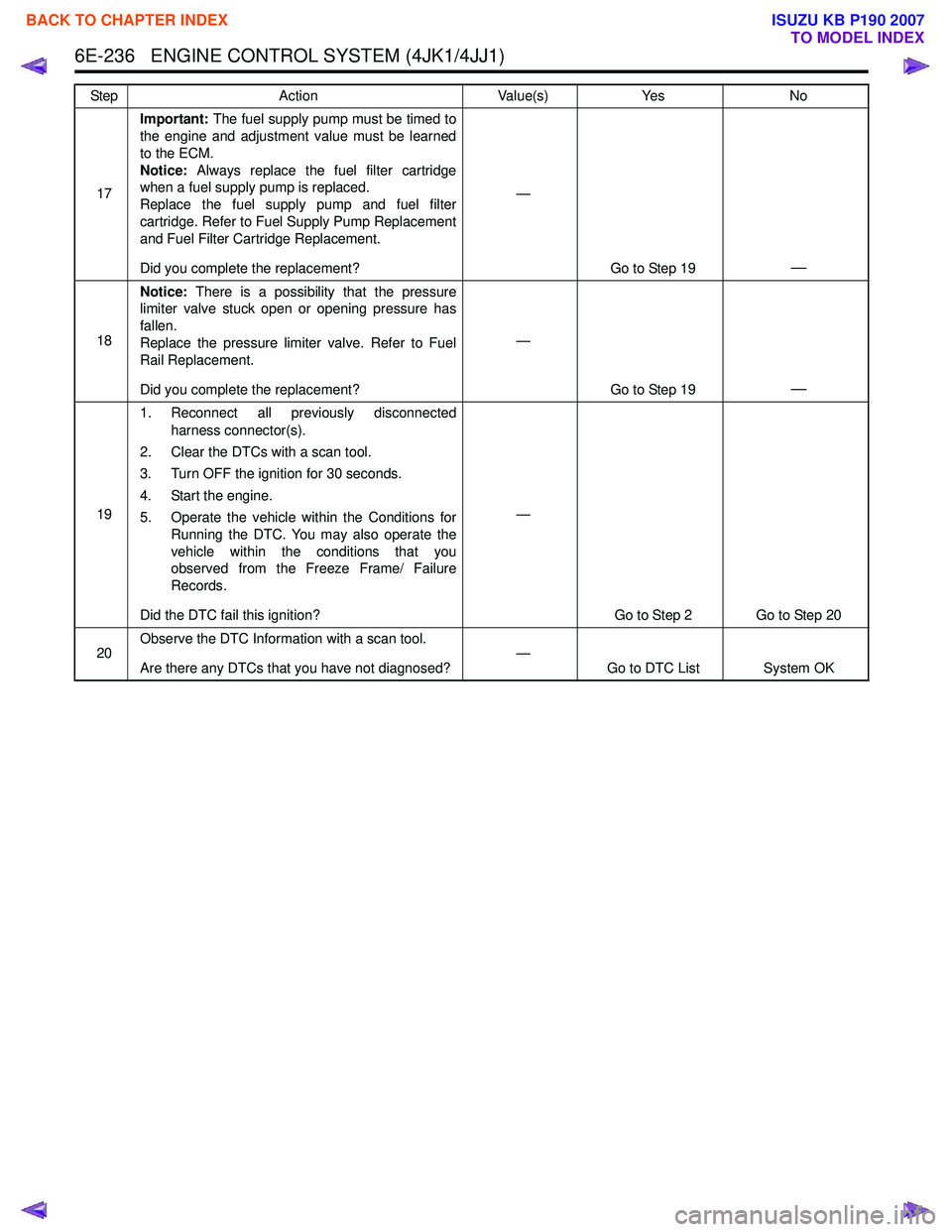
6E-236 ENGINE CONTROL SYSTEM (4JK1/4JJ1)
17Important:
The fuel supply pump must be timed to
the engine and adjustment value must be learned
to the ECM.
Notice: Always replace the fuel filter cartridge
when a fuel supply pump is replaced.
Replace the fuel supply pump and fuel filter
cartridge. Refer to Fuel Supply Pump Replacement
and Fuel Filter Cartridge Replacement.
Did you complete the replacement? —
Go to Step 19
—
18Notice:
There is a possibility that the pressure
limiter valve stuck open or opening pressure has
fallen.
Replace the pressure limiter valve. Refer to Fuel
Rail Replacement.
Did you complete the replacement? —
Go to Step 19
—
191. Reconnect all previously disconnected
harness connector(s).
2. Clear the DTCs with a scan tool.
3. Turn OFF the ignition for 30 seconds.
4. Start the engine.
5. Operate the vehicle within the Conditions for Running the DTC. You may also operate the
vehicle within the conditions that you
observed from the Freeze Frame/ Failure
Records.
Did the DTC fail this ignition? —
Go to Step 2 Go to Step 20
20 Observe the DTC Information with a scan tool.
Are there any DTCs that you have not diagnosed? —
Go to DTC List System OK
Step
Action Value(s)Yes No
BACK TO CHAPTER INDEX
TO MODEL INDEX
ISUZU KB P190 2007
Page 1930 of 6020
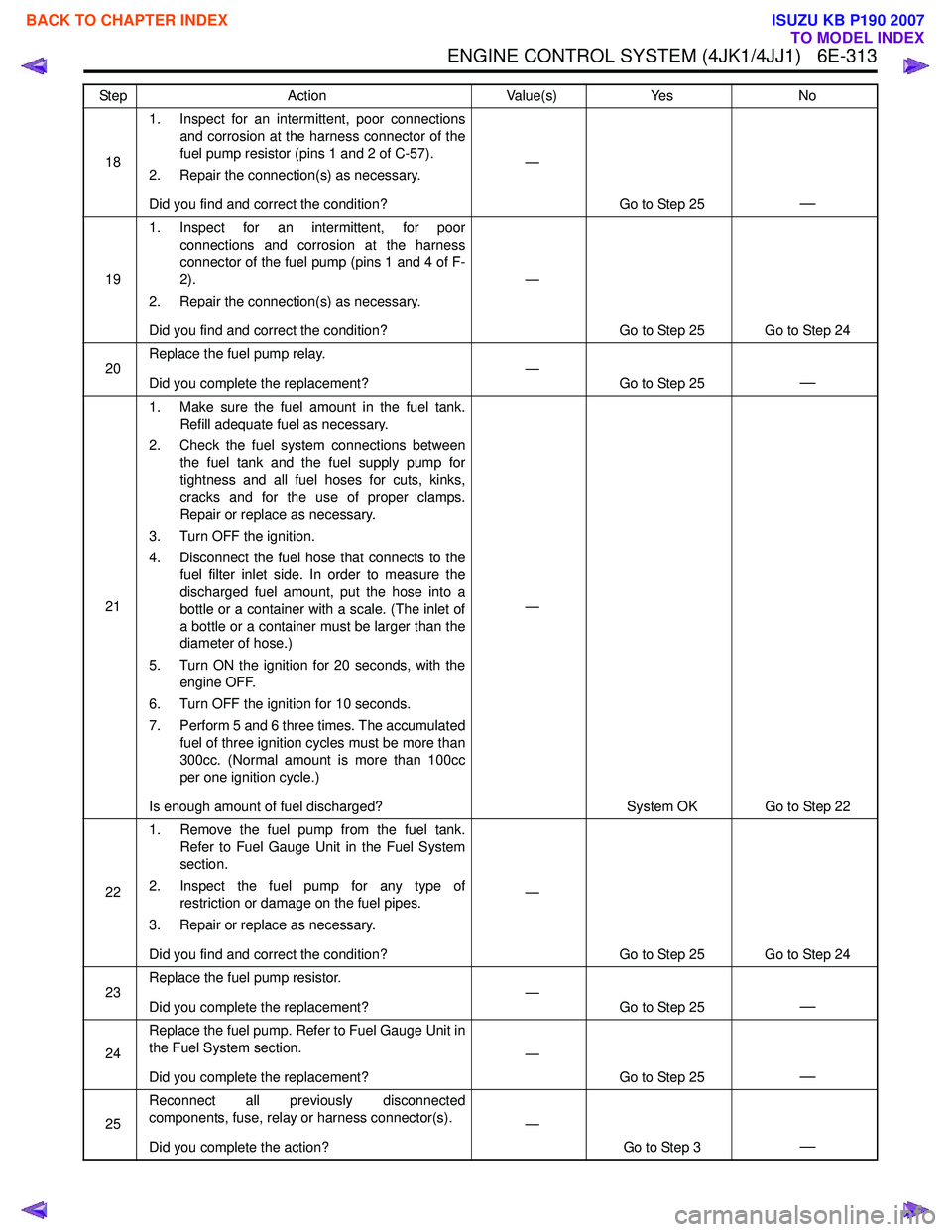
ENGINE CONTROL SYSTEM (4JK1/4JJ1) 6E-313
181. Inspect for an intermittent, poor connections
and corrosion at the harness connector of the
fuel pump resistor (pins 1 and 2 of C-57).
2. Repair the connection(s) as necessary.
Did you find and correct the condition? —
Go to Step 25
—
191. Inspect for an intermittent, for poor
connections and corrosion at the harness
connector of the fuel pump (pins 1 and 4 of F-
2).
2. Repair the connection(s) as necessary.
Did you find and correct the condition? —
Go to Step 25 Go to Step 24
20 Replace the fuel pump relay.
Did you complete the replacement? —
Go to Step 25
—
211. Make sure the fuel amount in the fuel tank.
Refill adequate fuel as necessary.
2. Check the fuel system connections between the fuel tank and the fuel supply pump for
tightness and all fuel hoses for cuts, kinks,
cracks and for the use of proper clamps.
Repair or replace as necessary.
3. Turn OFF the ignition.
4. Disconnect the fuel hose that connects to the fuel filter inlet side. In order to measure the
discharged fuel amount, put the hose into a
bottle or a container with a scale. (The inlet of
a bottle or a container must be larger than the
diameter of hose.)
5. Turn ON the ignition for 20 seconds, with the engine OFF.
6. Turn OFF the ignition for 10 seconds.
7. Perform 5 and 6 three times. The accumulated fuel of three ignition cycles must be more than
300cc. (Normal amount is more than 100cc
per one ignition cycle.)
Is enough amount of fuel discharged? —
System OK Go to Step 22
22 1. Remove the fuel pump from the fuel tank.
Refer to Fuel Gauge Unit in the Fuel System
section.
2. Inspect the fuel pump for any type of restriction or damage on the fuel pipes.
3. Repair or replace as necessary.
Did you find and correct the condition? —
Go to Step 25 Go to Step 24
23 Replace the fuel pump resistor.
Did you complete the replacement? —
Go to Step 25
—
24Replace the fuel pump. Refer to Fuel Gauge Unit in
the Fuel System section.
Did you complete the replacement? —
Go to Step 25
—
25Reconnect all previously disconnected
components, fuse, relay or harness connector(s).
Did you complete the action? —
Go to Step 3
—
Step Action Value(s)Yes No
BACK TO CHAPTER INDEX
TO MODEL INDEX
ISUZU KB P190 2007
Page 1945 of 6020
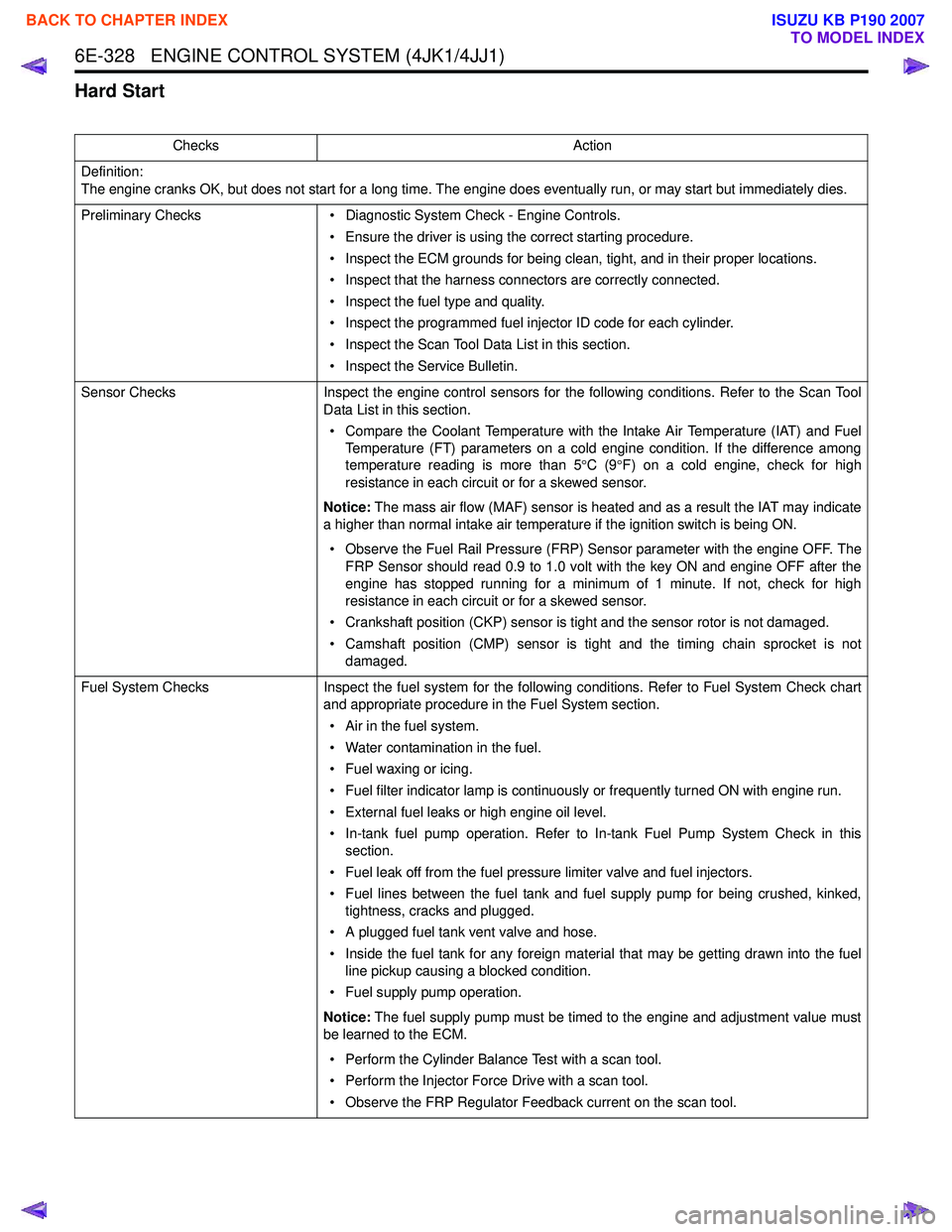
6E-328 ENGINE CONTROL SYSTEM (4JK1/4JJ1)
Hard Start
ChecksAction
Definition:
The engine cranks OK, but does not start for a long time. The engine does eventually run, or may start but immediately dies.
Preliminary Checks • Diagnostic System Check - Engine Controls.
• Ensure the driver is using the correct starting procedure.
• Inspect the ECM grounds for being clean, tight, and in their proper locations.
• Inspect that the harness connectors are correctly connected.
• Inspect the fuel type and quality.
• Inspect the programmed fuel injector ID code for each cylinder.
• Inspect the Scan Tool Data List in this section.
• Inspect the Service Bulletin.
Sensor Checks Inspect the engine control sensors for the following conditions. Refer to the Scan Tool
Data List in this section.
• Compare the Coolant Temperature with the Intake Air Temperature (IAT) and Fuel Temperature (FT) parameters on a cold engine condition. If the difference among
temperature reading is more than 5 °C (9 °F) on a cold engine, check for high
resistance in each circuit or for a skewed sensor.
Notice: The mass air flow (MAF) sensor is heated and as a result the IAT may indicate
a higher than normal intake air temperature if the ignition switch is being ON.
• Observe the Fuel Rail Pressure (FRP) Sensor parameter with the engine OFF. The FRP Sensor should read 0.9 to 1.0 volt with the key ON and engine OFF after the
engine has stopped running for a minimum of 1 minute. If not, check for high
resistance in each circuit or for a skewed sensor.
• Crankshaft position (CKP) sensor is tight and the sensor rotor is not damaged.
• Camshaft position (CMP) sensor is tight and the timing chain sprocket is not damaged.
Fuel System Checks Inspect the fuel system for the following conditions. Refer to Fuel System Check chart
and appropriate procedure in the Fuel System section.
• Air in the fuel system.
• Water contamination in the fuel.
• Fuel waxing or icing.
• Fuel filter indicator lamp is continuously or frequently turned ON with engine run.
• External fuel leaks or high engine oil level.
• In-tank fuel pump operation. Refer to In-tank Fuel Pump System Check in this section.
• Fuel leak off from the fuel pressure limiter valve and fuel injectors.
• Fuel lines between the fuel tank and fuel supply pump for being crushed, kinked, tightness, cracks and plugged.
• A plugged fuel tank vent valve and hose.
• Inside the fuel tank for any foreign material that may be getting drawn into the fuel line pickup causing a blocked condition.
• Fuel supply pump operation.
Notice: The fuel supply pump must be timed to the engine and adjustment value must
be learned to the ECM.
• Perform the Cylinder Balance Test with a scan tool.
• Perform the Injector Force Drive with a scan tool.
• Observe the FRP Regulator Feedback current on the scan tool.
BACK TO CHAPTER INDEX
TO MODEL INDEX
ISUZU KB P190 2007